|
|
|
Sort Order |
|
|
|
Items / Page
|
|
|
|
|
|
|
| Srl | Item |
| 1 |
ID:
115590
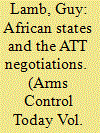

|
|
|
| 2 |
ID:
114128
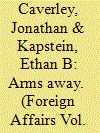

|
|
|
|
|
| Publication |
2012.
|
| Summary/Abstract |
For two decades, the United States has dominated the global arms trade, reaping a broad range of economic and geopolitical benefits in the process. But shortsighted decisions to produce expensive, cutting-edge weapons systems, rather than cheaper, more practical ones, are squandering this monopoly and letting other countries get into the market.
|
|
|
|
|
|
|
|
|
|
|
|
|
|
|
|
| 3 |
ID:
110167
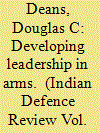

|
|
|
| 4 |
ID:
192056
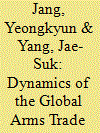

|
|
|
|
|
| Summary/Abstract |
This study identifies security-related factors affecting the formation of the global arms trade network. This empirical analysis using a quantitative approach includes data from multiple sources (the Global Peace Index, Political Stability Index, Democracy Index, Global Terrorism Index, Fragile State Index, and military expenditure as a percentage of GDP) and multiple states analyzed using the ERGM. Arms trade data related to six attributes of states representing their (in)stability is collected and analyzed for 2012-2018. Our findings are as follows: (1) states with greater internal stability import more arms, which affects the formation of the global arms trade network; (2) states with greater external instability import more arms, which also affects the formation of the global arms trade network. This study makes two academic contributions, as follows. First, we analyze factors that form the global arms trade network from a holistic or systemic perspective. Second, we analyze those factors empirically and statistically from a security perspective.
|
|
|
|
|
|
|
|
|
|
|
|
|
|
|
|
| 5 |
ID:
097425
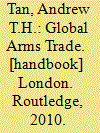

|
|
|
|
|
| Publication |
London, Routledge, 2010.
|
| Description |
xxiv, 390p.Hbk
|
| Standard Number |
9781857434972, hbk
|
|
|
|
|
|
|
|
|
|
|
|
Copies: C:1/I:0,R:1,Q:0
Circulation
| Accession# | Call# | Current Location | Status | Policy | Location |
| 055067 | 382.41/TAN 055067 | Main | On Shelf | Reference books | |
|
|
|
|
| 6 |
ID:
142246
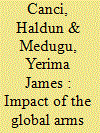

|
|
|
| 7 |
ID:
129133
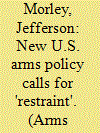

|
|
|
|
|
| Publication |
2014.
|
| Summary/Abstract |
The Obama administration in January announced a new policy on conventional arms transfers that emphasizes the need for restraint in considering transfers that might endanger regional security or human rights. President Barack Obama declared in a Jan. 15 directive that the new policy "supports transfers that meet legitimate security requirements of our allies and partners in support of our national security and foreign policy interests" and "promotes restraint" in those "that may be destabilizing or dangerous to international peace and security." The policy, which replaces a 1995 directive issued by President Bill Clinton, follows the administration's announcement last October that it was loosening rules on the sale of U.S.-made weapons overseas. The reforms announced last fall are part of an effort that the administration says will tighten controls on the sale of the most dangerous arms while enhancing commerce in defense material and services that are not threatening.
|
|
|
|
|
|
|
|
|
|
|
|
|
|
|
|
| 8 |
ID:
129105
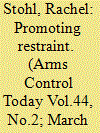

|
|
|
|
|
| Publication |
2014.
|
| Summary/Abstract |
On January 15, 2014, the United States released a document describing its new policy governing transfers of conventional weapons. The policy revision was long overdue, as the new publicly released document, Presidential Policy Directive 27 (PPD-27),[1] replaced a classified directive that came out in 1995.[2] The world has changed dramatically since the end of the Cold War. Until the release of the new policy document, however, the United States had been using policy guidance rooted in the geopolitical challenges created by the fall of the Soviet Union in making its arms transfer decisions and in outlining policy priorities and approaches to the global arms trade. According to a White House summary, a multi-year interval review of U.S. arms export policy "concluded that the 1995 conventional arms transfer policy was effective but needed to be updated to address 21st century national security and foreign policy objectives."[3] Thus, the new U.S. policy more accurately reflects the reality of U.S. arms transfers today. The Obama administration began its review when it came into office, but U.S. officials have said the impetus to finish the review came from events during the Arab Spring, when canisters of tear gas emblazoned with "Made in the USA" dominated pictures of the uprisings in Cairo's Tahrir Square. Questions surrounding U.S. arms sales to Egypt and other Arab countries led to increased scrutiny over the process of determining whether to transfer conventional arms and whether arms sales in fact led to U.S. influence over the recipient.
|
|
|
|
|
|
|
|
|
|
|
|
|
|
|
|
| 9 |
ID:
121245
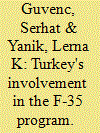

|
|
|
|
|
| Publication |
2013.
|
| Summary/Abstract |
Turkey has been involved in the international consortium that builds the
F-35 Joint Strike Fighter (JSF) since 1999. The relationship between Turkey
and the consortium may appear to be rocky, however, because of Turkey's
many hesitations to commit to the JSF program. In this article we argue that
these hesitations are strategic, designed to extract maximum benefits for
Turkey's defence industry from the consortium manufacturing the fighter
jets. For in addition to wanting to buy these fighter jets, Turkey seeks to
maximize the amount of local work-share to secure access to the software
of the aircraft, and to accumulate enough experience that will eventually
lead to designing and manufacturing a "fully indigenous" combat aircraft.
|
|
|
|
|
|
|
|
|
|
|
|
|
|
|
|
| 10 |
ID:
108631
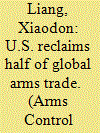

|
|
|
|
|
| Publication |
2011.
|
| Summary/Abstract |
Although the value of its arms sales agreements dipped slightly in 2010, the United States registered a marked increase in its share of the global arms trade as spending on imported conventional weapons systems dropped sharply worldwide, according to a recently released Congressional Research Service report.
|
|
|
|
|
|
|
|
|
|
|
|
|
|
|
|
|
|
|
|
|